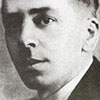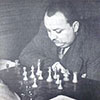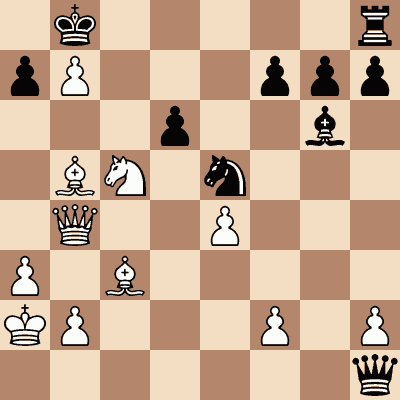Roberto Grau vs. Edgar Colle
The confrontation between the Argentinian chess master, Roberto Grau and the Belgian chess master Edgar Colle ended in a victory for white after a 3 moves including an unexpected sacrifice.
Roll over to see the solution: 1. Na6+ Kxb7 2. Bd7+ Kxa6 3. Qb5#
FEN: 1k5r/pP3ppp/3p2b1/1BN1n3/1Q2P3/P1B5/KP3P1P/7q w - - 1 0
About the players
 Edgar Colle (1897-1932) was a Belgian chess Master with excellent results in the major international tournaments of his time.
Edgar Colle (1897-1932) was a Belgian chess Master with excellent results in the major international tournaments of his time.  Roberto Grau (1900-1944) was a well known Argentinian chess Master.
Roberto Grau (1900-1944) was a well known Argentinian chess Master. 
Extremely beautiful! After 1. Na6+!, White forces the Black King to enter a territory (1…Kxb7 – forced), which is dominated (in squares) by the White Queen and the white light pieces; the Black King cannot escape to the side since the c6 and c7 squares are controlled by the white B and N respectively, while his only “escape square” (a7) is already occupied by the black pawn, hence blocked.
The discovery check afterward comes naturally: 2. Bd7+!! and the rest is a forced checkmate.
E. Colle is more known (to me, at least) for his “Colle System”, an impenetrable but stiff and not quite flexible opening “system”. It is regularly combined with (or aiming to) the “Greek Gift sac” (Bxh7+).
Na6+
Bd7+
Qb5+#
Blacks take the pawn but…1.Na6+ Kxb7 2.Bc4+ Ka8 3.Bd5+ Nc6 4.Bxc6#
1. Na6+
2.Ba4+
3Qb5+#
USCF Life Master Arthur Braden :: To Tsamis > Someone as creative as Colle was, would readily notice that after 1. Na6+ Kxb7 that both 2. Ba4+ and 2. Be8+ would add variety/beauty without sacrificing efficiency since it 2. … Kc8 then 3. Qb8 Mate. By USCF posthumous calculations Colle was rated 2490 over a 5 year period (https://www.gwern.net/docs/statistics/comparison/1978-elo-theratingofchessplayerspastandpresent.pdf), which would make him at least a Senior Master (not just a “Master”) 🙂 :: Badusha > Always give a reply for other responses. If 1. Na6+ Kxb7 2. Bd7+ Ka8 (?) … but then 3. Nc7 Mate. With quick mates like this you cannot argue, “That reply is obvious.” , since the reader, who may not be a strong enough player to quickly see a response, can find it and assume you did not see it. :: Cardoso > These problems are labeled Mate in 3, but if you are looking for the Mate in 4 then after 1. Na6+ Kxb7 2. Bc4+ you are not covering the King’s escape on c8, so 2. … Kc8 3. Qb8+ Kd7 4. Qc7+ Ke8 the mating is taking more than 4 moves … but there are mates here, such as 5. Bb5+ Nd7 6. Qxd7+ Kf8 7. Qd8 Mate. 🙂 [I am on Facebook if you would like to talk more about this.]